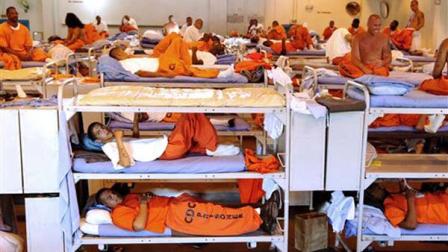SPEAKERS, MUSIC, ART, POETRY, FOOD, CANDLELIGHT VIGIL REMEMBERING THOSE IMPACTED BY THE WAR ON DRUGS and more... click banner for info
Gov. Jerry Brown is a reluctant prison reformer; in his former job as attorney general, he fought hard to stave off a federal court order requiring the state to reduce its inmate population. But with Monday's ruling by the U.S. Supreme Court upholding that order, Brown can't put off the big decisions anymore — and neither can the Legislature, which has been ignoring the prison problem for decades.
Perhaps because he understood the weakness of his own case, Brown seems to have been prepared for Monday's ruling in Brown vs. Plata, in which a 5-4 Supreme Court majority agreed that California's prison conditions were so bad that they violated the U.S. Constitution's ban on cruel and unusual punishment. Earlier this year he released a proposal for transferring thousands of inmates from state prisons to county jails, and last month he signed a bill, AB 109, to accomplish that. But that may not suffice.
Perhaps because he understood the weakness of his own case, Brown seems to have been prepared for Monday's ruling in Brown vs. Plata, in which a 5-4 Supreme Court majority agreed that California's prison conditions were so bad that they violated the U.S. Constitution's ban on cruel and unusual punishment. Earlier this year he released a proposal for transferring thousands of inmates from state prisons to county jails, and last month he signed a bill, AB 109, to accomplish that. But that may not suffice.
At last count there were 142,000 inmates in California prisons, which are so overcrowded that some prisoners must be housed collectively in gymnasiums or alone in phone-booth-sized cages. Under the order upheld by the Supreme Court, the state must reduce its inmate population to 137.5% of the system's capacity — meaning about 110,000 — within two years.
Brown's plan to shift nonviolent offenders to county facilities is a partial solution. But the state would have to pay counties to take its prisoners, so the plan requires the Legislature, and ultimately voters, to approve an extension of the 2009 temporary tax hikes to fund the transfers. Those taxes are a subject of fierce debate as lawmakers bicker over closing the state's yawning multibillion-dollar deficit. Moreover, as it stands now, Brown's plan would cut the state inmate population by about 30,000 within three years, one year later than the federal order requires.
In his dissent, Justice Samuel A. Alito Jr. argued histrionically that California was being mandated to release "the equivalent of three Army divisions" of criminals onto its streets; similarly, Justice Antonin Scalia wrote that "terrible things are sure to happen as a consequence of this outrageous order." But the truth is that experts have been suggesting responsible ways to ease prison overcrowding for years. One way is to create an independent panel to revise the state's haphazard sentencing guidelines, which all too often result in excessive terms that worsen overcrowding. In other states, sentencing commissions have lengthened penalties for truly dangerous felons while finding alternative punishments for minor offenders.
Gov. Arnold Schwarzenegger backed such a commission, but he couldn't get the Legislature to go along. Maybe the threat of wide-scale prisoner releases can finally scare our lawmakers straight.
Brown's plan to shift nonviolent offenders to county facilities is a partial solution. But the state would have to pay counties to take its prisoners, so the plan requires the Legislature, and ultimately voters, to approve an extension of the 2009 temporary tax hikes to fund the transfers. Those taxes are a subject of fierce debate as lawmakers bicker over closing the state's yawning multibillion-dollar deficit. Moreover, as it stands now, Brown's plan would cut the state inmate population by about 30,000 within three years, one year later than the federal order requires.
In his dissent, Justice Samuel A. Alito Jr. argued histrionically that California was being mandated to release "the equivalent of three Army divisions" of criminals onto its streets; similarly, Justice Antonin Scalia wrote that "terrible things are sure to happen as a consequence of this outrageous order." But the truth is that experts have been suggesting responsible ways to ease prison overcrowding for years. One way is to create an independent panel to revise the state's haphazard sentencing guidelines, which all too often result in excessive terms that worsen overcrowding. In other states, sentencing commissions have lengthened penalties for truly dangerous felons while finding alternative punishments for minor offenders.
Gov. Arnold Schwarzenegger backed such a commission, but he couldn't get the Legislature to go along. Maybe the threat of wide-scale prisoner releases can finally scare our lawmakers straight.






